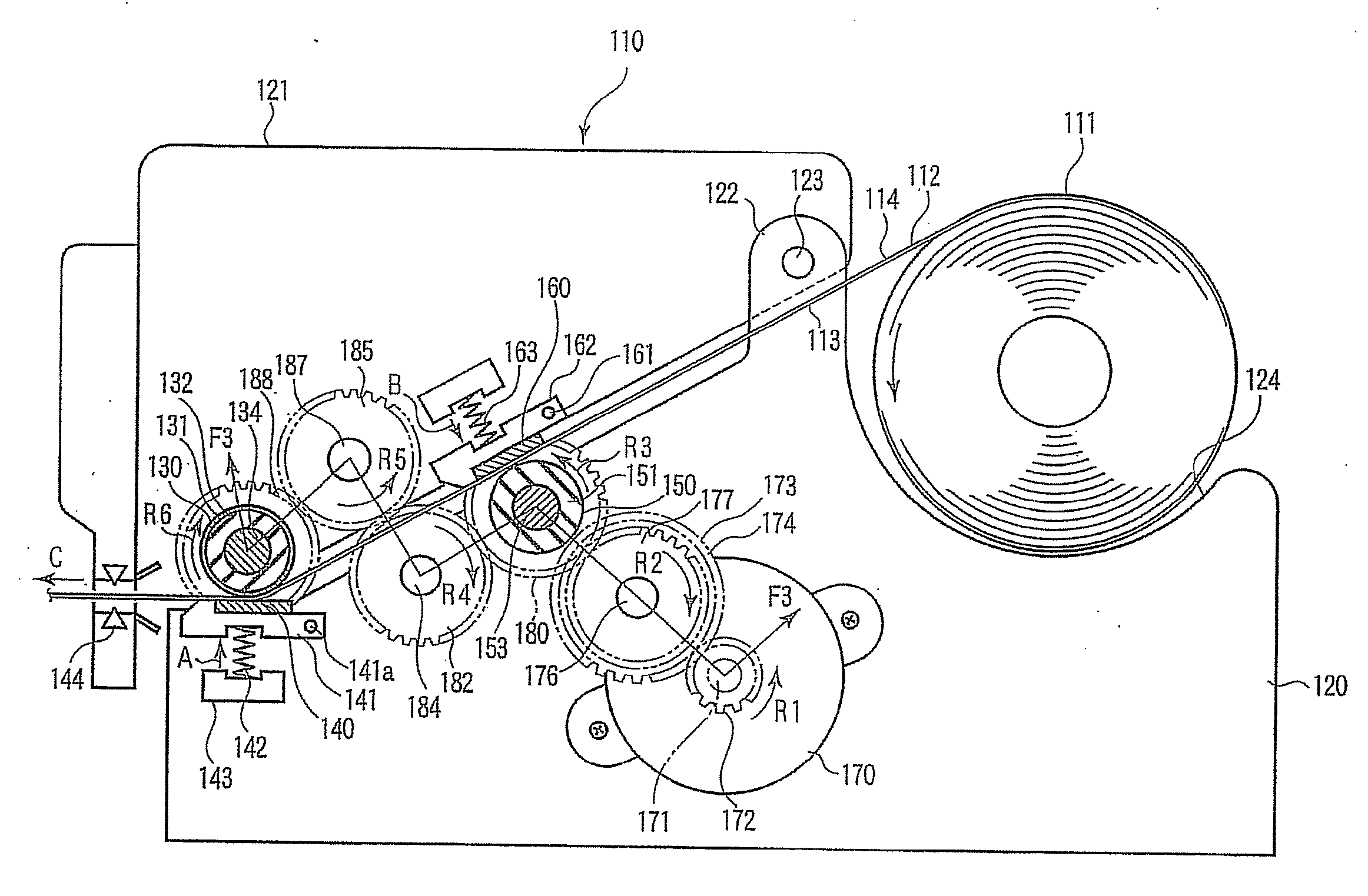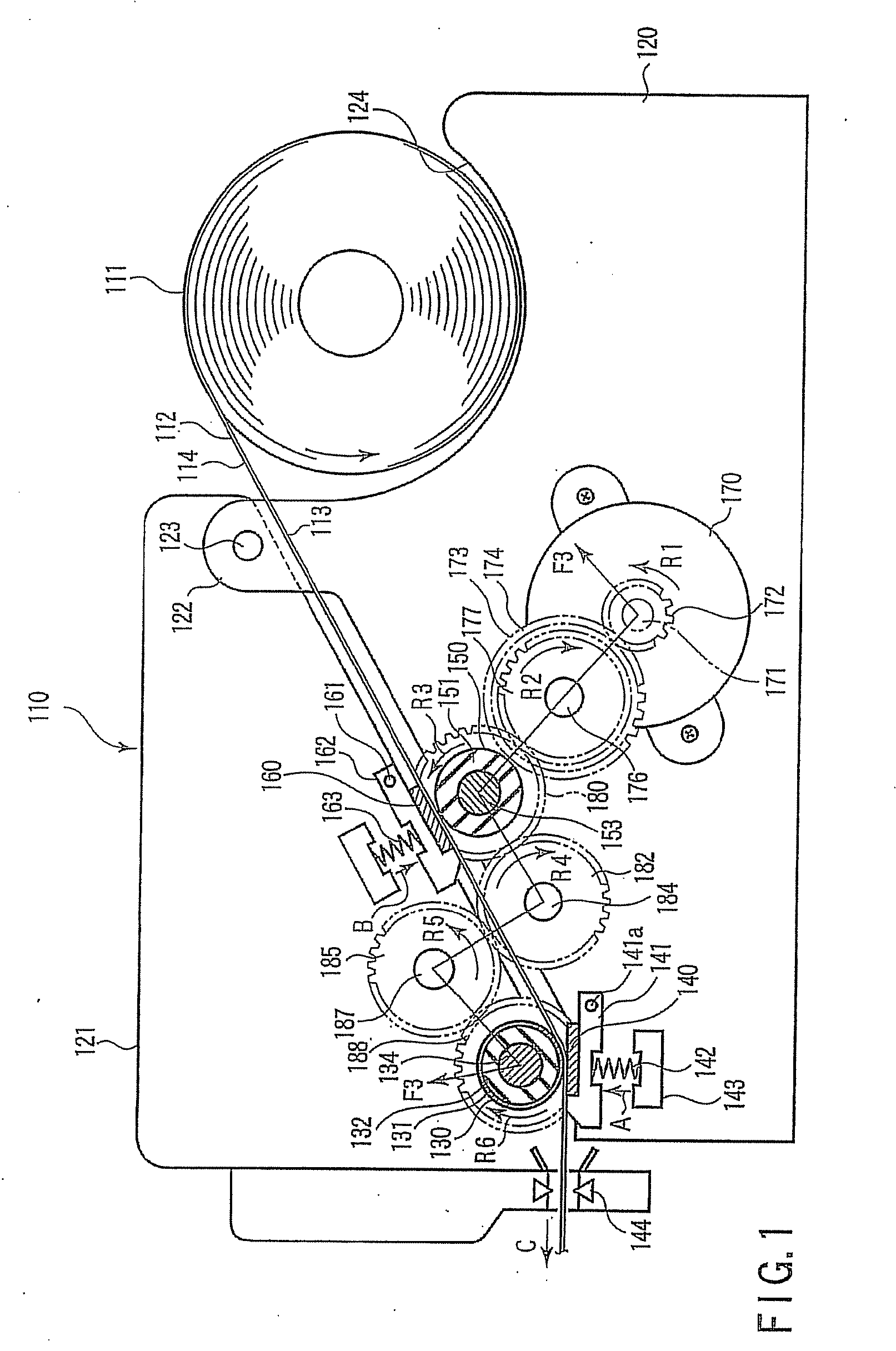Printing apparatus
a printing machine and printing plate technology, applied in printing, typewriters, instruments, etc., can solve the problems of waste, limited control of the outer diameter and feed speed of the platen roller, and the inability to accurately manage the outer diameter and feed speed in the platen roller, etc., to achieve smooth paper conveying
- Summary
- Abstract
- Description
- Claims
- Application Information
AI Technical Summary
Benefits of technology
Problems solved by technology
Method used
Image
Examples
first embodiment
[0055]FIG. 1 schematically shows an inside of a thermal printer 110 according to a first embodiment of the invention. The thermal printer 110 can carry out printing on both surfaces of thermal recording paper 111. For example, the thermal printer 110 can be used in a cash register of a store.
[0056]As shown in FIG. 2, the thermal recording paper 111 includes a base paper 112 and heat-sensitive layers 113 and 114 which are formed on both the surfaces of the base paper 112. The first heat-sensitive layer 113 is formed on one side (for example, surface) of the base paper 112, and the second heat-sensitive layer 114 is formed on the other side (for example, backside) of the base paper 112. Each of the heat-sensitive layers 113 and 114 is made of a material which develops a desired color such as black and red when heated to a predetermined temperature or more. As shown in FIG. 1, the thermal recording paper 111 is wound in a roll shape such that the first heat-sensitive layer 113 faces th...
second embodiment
[0087]A thermal printer 190 according to a second embodiment of the invention will be described below.
[0088]The second embodiment differs from the first embodiment only in the first and second platen rollers 130 and 150 and first and second biasing means 191 and 192. Thus, the same components are designated by the same numerals and the description thereof is omitted.
[0089]In the second embodiment, a first platen roller 130a and a second platen roller 150a are formed by roller bodies 131a and 151a made of NBR respectively. The first platen roller 130a is slightly larger than the second platen roller 150a in the diameter.
[0090]The first biasing means 191 is smaller than the second biasing means 192 in a spring constant. For example, a wire diameter in the spring of the first biasing means 191 is smaller than that of the second biasing means 192. Therefore, the force with which the first thermal head 140 is pressed against the first platen roller 130a by the first biasing means 191 bec...
third embodiment
[0096]FIG. 6 schematically shows an inside of a thermal printer 210. The thermal printer 210 can carry out printing on both surfaces of thermal recording paper 211. For example, the thermal printer 210 can be used in a cash register of a store.
[0097]As shown in FIG. 7, the thermal recording paper 211 includes a base paper 212 and heat-sensitive layers 213 and 214 which are formed on both the surfaces of the base paper 212. The first heat-sensitive layer 213 is formed on one side (for example, surface) of the base paper 212, and the second heat-sensitive layer 214 is formed on the other side (for example, backside) of the base paper 212. Each of the heat-sensitive layers 213 and 214 is made of a material which develops a desired color such as black and red when heated to a predetermined temperature or more. As shown in FIG. 6, the thermal recording paper 211 is wound in the roll shape such that the first heat-sensitive layer 213 faces the inside.
[0098]The thermal printer 210 includes...
PUM
 Login to View More
Login to View More Abstract
Description
Claims
Application Information
 Login to View More
Login to View More - R&D
- Intellectual Property
- Life Sciences
- Materials
- Tech Scout
- Unparalleled Data Quality
- Higher Quality Content
- 60% Fewer Hallucinations
Browse by: Latest US Patents, China's latest patents, Technical Efficacy Thesaurus, Application Domain, Technology Topic, Popular Technical Reports.
© 2025 PatSnap. All rights reserved.Legal|Privacy policy|Modern Slavery Act Transparency Statement|Sitemap|About US| Contact US: help@patsnap.com



